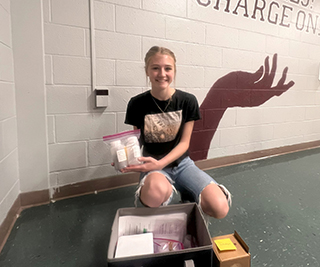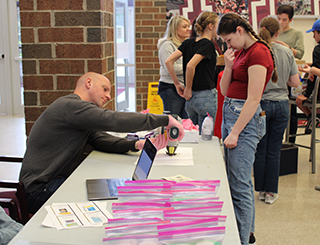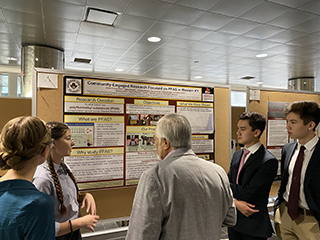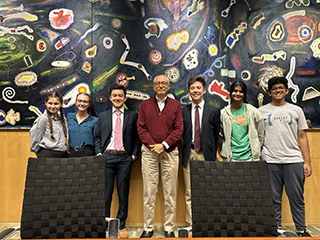February 23, 2024

A Henderson County High School student holds kits for collecting water and soil samples for PFAS analysis. (Photo courtesy of Jamie Young Wise, taken by Sarah Jump)
When a high school chemistry teacher in western Kentucky learned about PFAS-contaminated water in her community, she wanted to encourage her students to help address this local environmental health issue. She connected with the Center for Integrative Environmental Health Sciences (CIEHS) at the University of Louisville – part of the NIEHS Environmental Health Sciences Core Centers Program – and together, they developed a research project for students in the Henderson County High School science club to learn more about PFAS.
Led by CIEHS member Jamie Young Wise, Ph.D., the project enabled about 20 students to conduct hands-on research by collecting and analyzing water samples for PFAS. The students gained valuable insight into how environmental health research is conducted and how they can get involved in addressing water contamination issues in their community.
“They get a love of science and citizen science, and they can have an active role in exploring science all around them,” said Sherry Blosser, a Henderson County High School teacher who helps lead the project. “Most of all, I hope it inspires them to get into STEM and shows that they can do science in college and beyond.”
Sampling for PFAS

Specht helped students analyze their samples for PFAS using his handheld XRF devices. (Photo courtesy of Jamie Young Wise, taken by Sarah Jump)
With the assistance of Luz Huntington-Moskos, Ph.D., director of the CIEHS Community Engagement Core, Young Wise taught the students about PFAS, its potential sources, and possible health effects of exposure. After learning that PFAS were detected in drinking water throughout Kentucky, the students were worried about possible contamination in their own homes.
“When I initially found out about PFAS, the main feeling was fear,” recalled Allina Decker, a student in the science club. “Afterwards, it sparked a kind of passion and made me want to do something about it.”
The students collected water samples from their community with sample kits that Young Wise and Huntington-Moskos assembled. Next, Young Wise invited Aaron Specht, Ph.D., from Purdue University, to help the students assess how much PFAS might be in their samples. Specht brought along a handheld X-ray fluorescence (XRF) device, which generates real time measurements of fluorine, a proxy for PFAS, in the samples.
“Dr. Specht presented to the students about the XRF device and got them excited about using this technology to measure PFAS,” said Young Wise. “And the real time readouts were instant gratification. Even community members who weren’t involved in this project were intrigued.”
The students collected 41 water samples, 25 of which contained fluorine, an indicator that PFAS may be present in those water sources.
Sharing Their Science

The students presented their research to CIEHS Director, Christopher States, Ph.D., (center) at Research!Louisville 2023. (Photo courtesy of Jamie Young Wise, taken by Sarah Jump)
The students also learned how to communicate about science. Sarah Jump, coordinator of marketing and communication for the CIEHS, and Huntington-Moskos coached the students in science communication and how to share their findings with the public. According to Young Wise, the lessons helped the students feel more confident when speaking to reporters for a local news story about the project.
The students got a chance to share their results and practice their science communication skills at Research!Louisville 2023, an event hosted by University of Louisville. To prepare, the students created a poster summarizing their research methods and results and then presented their work to event attendees, including NIEHS Director, Rick Woychik, Ph.D. They were given the opportunity to speak directly with Woychik after their presentation.
“The students were just glowing, they were so interested in the work they were doing,” said Young Wise. “Seeing them so excited was amazing. This is the stuff that feeds the soul.”
Looking Towards the Future

Students posed with Woychik (center) at Research!Louisville 2023. (Photo courtesy of Jamie Young Wise, taken by Sarah Jump)
Young Wise and the students are in the process of sharing their initial findings with the community. Once residents who had measurable levels of fluorine in their water are notified, the students will present their work to the broader community in spring 2024. Then, they will resample and analyze the water sources that potentially contain PFAS to confirm the presence of PFAS in those sources.
In the future, Young Wise hopes to teach the students about other sampling techniques, including measuring PFAS in pill bugs and animal tissues. According to Young Wise, this would allow the students to compare the results of different sampling methods and may provide more opportunities for outside community members to participate in the project.
“I think it’s really important to get our younger scientists involved in the community and environmental health early,” said Young Wise. “It helps them understand what’s possible and gives them an appetite for science. It’s so important that opportunities like these are there for students.”


